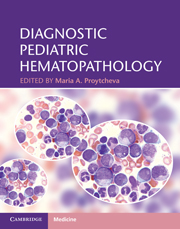Book contents
- Frontmatter
- Contents
- List of contributors
- Acknowledgements
- Introduction
- Section 1 General and non-neoplastic hematopathology
- Section 2 Neoplastic hematopathology
- 10 Chromosome abnormalities of hematologic malignancies
- 11 Expression profiling in pediatric acute leukemias
- 12 Myeloproliferative neoplasms
- 13 Myelodysplastic/myeloproliferative neoplasms
- 14 Myelodysplastic syndromes and therapy-related myeloid neoplasms
- 15 Acute myeloid leukemia and related precursor neoplasms
- 16 Hematologic abnormalities in individuals with Down syndrome
- 17 Precursor lymphoid neoplasms
- 18 Advances in prognostication and treatment of pediatric acute leukemia
- 19 The effect of chemotherapy, detection of minimal residual disease, and hematopoietic stem cell transplantation
- 20 Pediatric small blue cell tumors metastatic to the bone marrow
- 21 Pediatric mature B-cell non-Hodgkin lymphomas
- 22 Pediatric mature T-cell and NK-cell non-Hodgkin lymphomas
- 23 Hodgkin lymphoma
- 24 Immunodeficiency-associated lymphoproliferative disorders
- 25 Histiocytic proliferations in childhood
- 26 Cutaneous and subcutaneous lymphomas in children
- Index
- References
15 - Acute myeloid leukemia and related precursor neoplasms
from Section 2 - Neoplastic hematopathology
Published online by Cambridge University Press: 03 May 2011
- Frontmatter
- Contents
- List of contributors
- Acknowledgements
- Introduction
- Section 1 General and non-neoplastic hematopathology
- Section 2 Neoplastic hematopathology
- 10 Chromosome abnormalities of hematologic malignancies
- 11 Expression profiling in pediatric acute leukemias
- 12 Myeloproliferative neoplasms
- 13 Myelodysplastic/myeloproliferative neoplasms
- 14 Myelodysplastic syndromes and therapy-related myeloid neoplasms
- 15 Acute myeloid leukemia and related precursor neoplasms
- 16 Hematologic abnormalities in individuals with Down syndrome
- 17 Precursor lymphoid neoplasms
- 18 Advances in prognostication and treatment of pediatric acute leukemia
- 19 The effect of chemotherapy, detection of minimal residual disease, and hematopoietic stem cell transplantation
- 20 Pediatric small blue cell tumors metastatic to the bone marrow
- 21 Pediatric mature B-cell non-Hodgkin lymphomas
- 22 Pediatric mature T-cell and NK-cell non-Hodgkin lymphomas
- 23 Hodgkin lymphoma
- 24 Immunodeficiency-associated lymphoproliferative disorders
- 25 Histiocytic proliferations in childhood
- 26 Cutaneous and subcutaneous lymphomas in children
- Index
- References
Summary
Introduction
Acute myeloid leukemia (AML) is a group of clonal malignant disorders of the bone marrow and peripheral blood that morphologically, cytochemically, and immunophenotypically manifest variable degrees of maturation resembling various stages and lineages in normal hematopoietic development. The intense research efforts of the past 30 years have led to major advances in our understanding of the pathogenesis, diagnosis, and treatment of AML. More recently, the completion of the human genome project has fueled the development of methods for the determination of global gene expression and the genome-wide assessment of DNA mutations. These techniques will enhance our knowledge of the underlying genetic lesions responsible for the development of AML, and, importantly for the pathologist, they will undoubtedly revolutionize the classification of AML. Historically, the classification of AML has had relatively little impact on patient care, since most patients with AML were treated with fairly uniform chemotherapeutic regimens and generally had a poor prognosis. However, through the research efforts alluded to above, a classification scheme for AML with clinical utility is starting to emerge. Furthermore, with the advent of chemotherapeutics for AML which specifically target the underlying genetic lesions, the paradigm being all-trans retinoic acid (ATRA) for the treatment of acute promyelocytic leukemia, there is now greater impetus for the precise and meaningful classification of AML.
- Type
- Chapter
- Information
- Diagnostic Pediatric Hematopathology , pp. 272 - 309Publisher: Cambridge University PressPrint publication year: 2011
References
- 1
- Cited by



